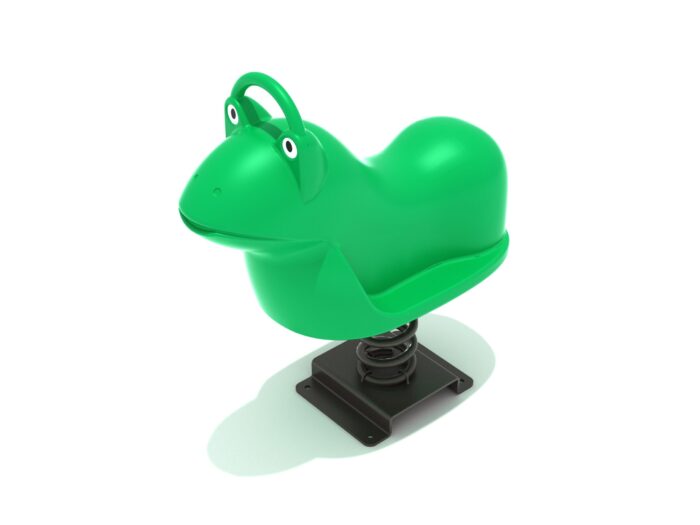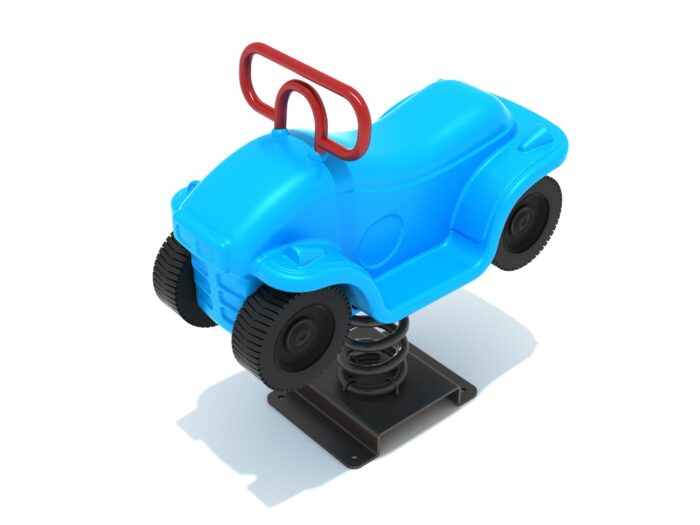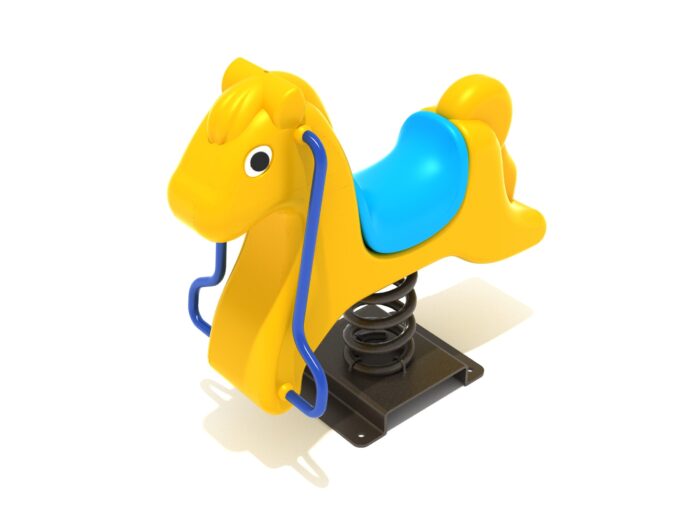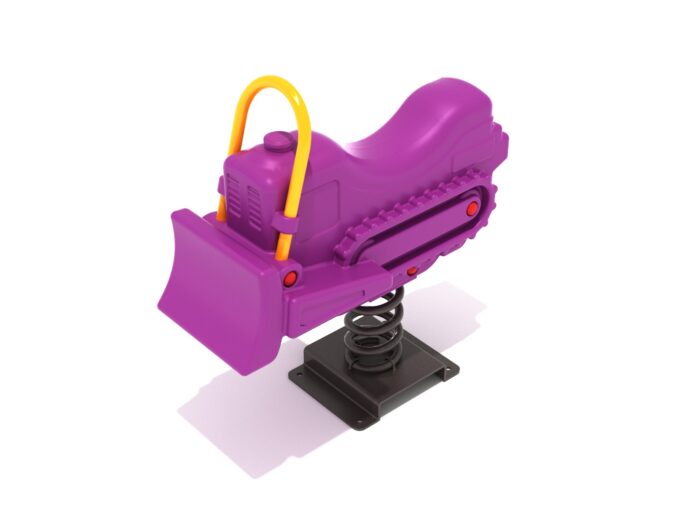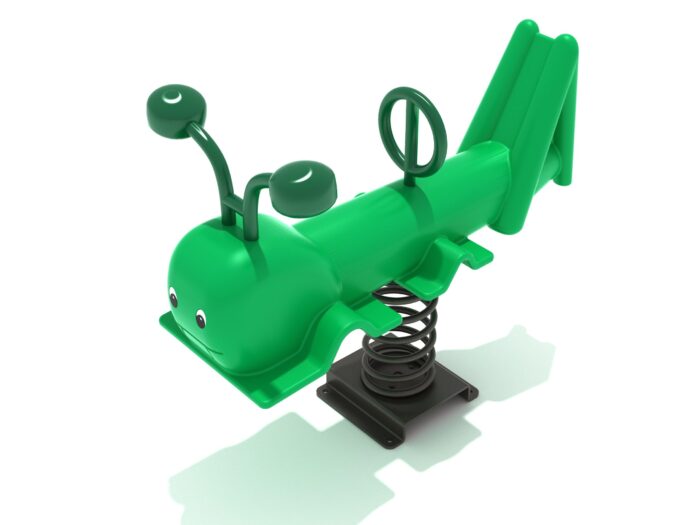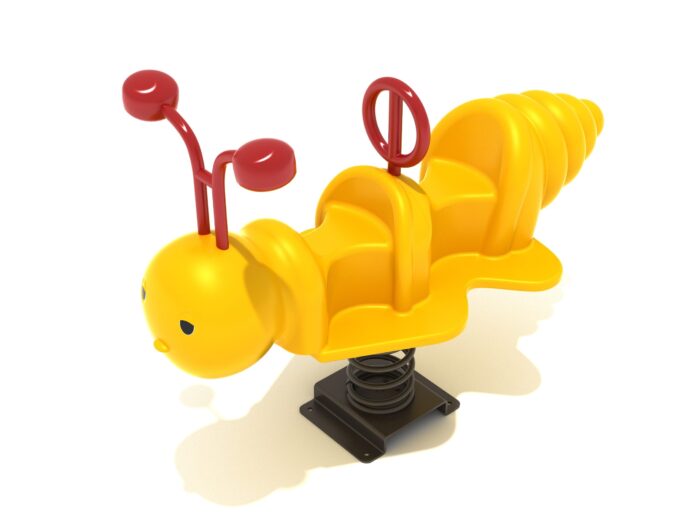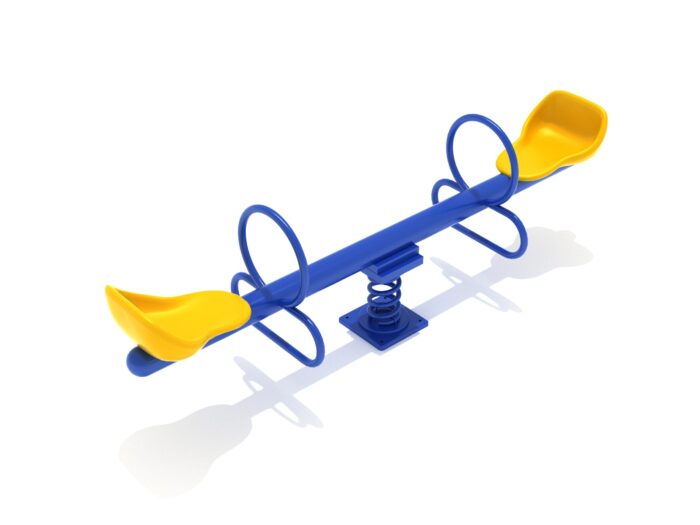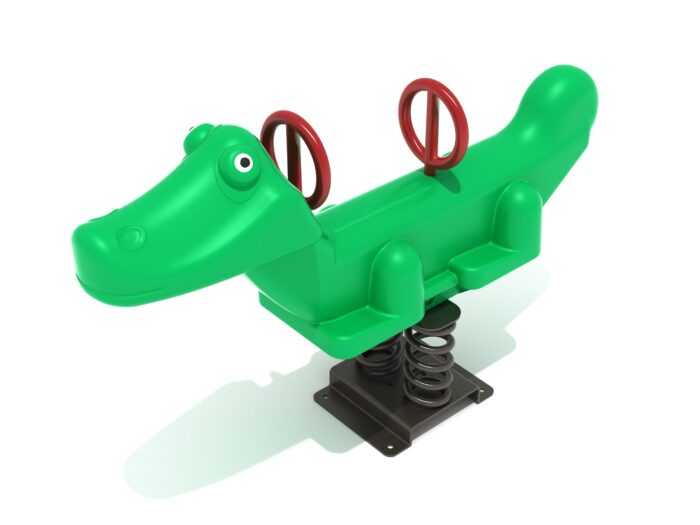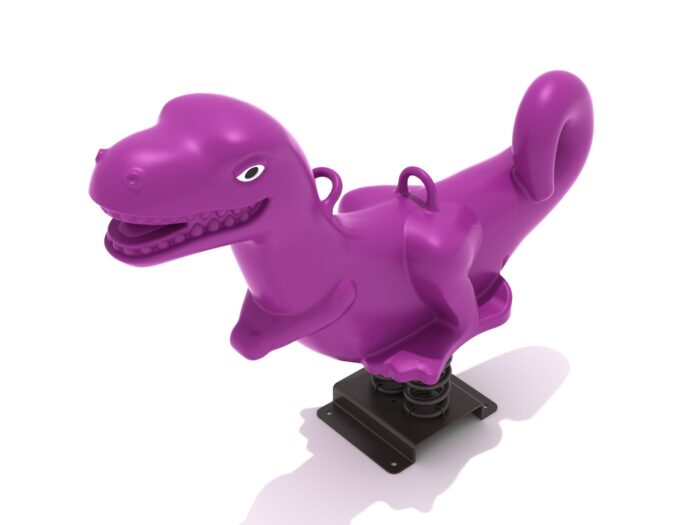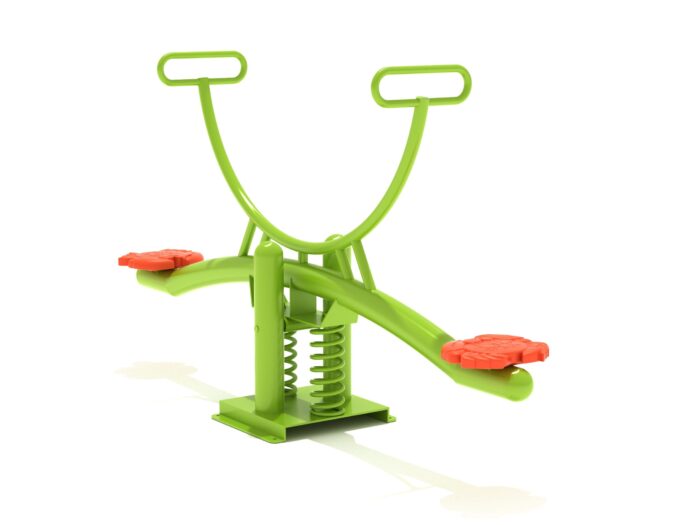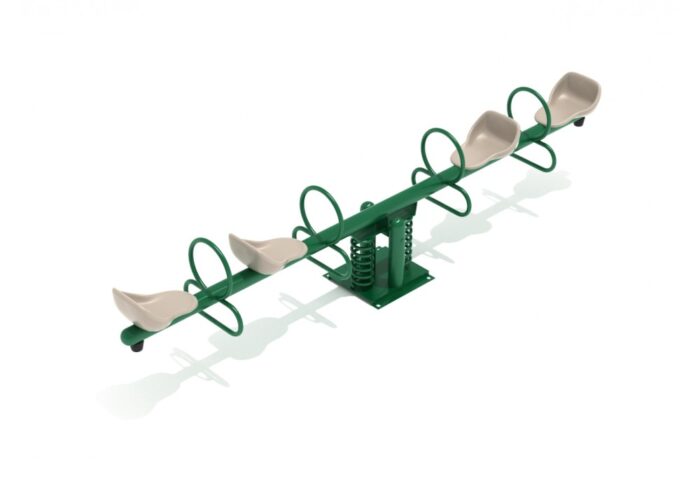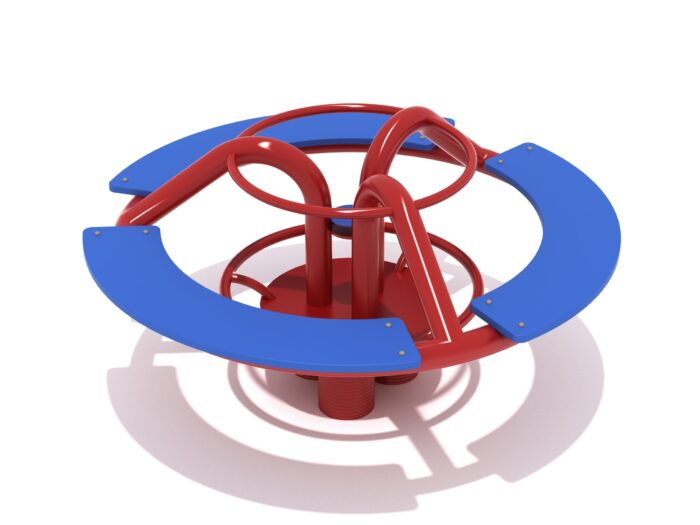Your cart is currently empty!
Springs
- Bouncers
- Components
- Free Standing Play
- Teeter Totters
Showing all 12 results
-
Frankie Frog Fun Bounce
$493.00 -
Taylor Truck Fun Bounce
$493.00 -
Pattie Pony Fun Bounce
$493.00 -
Bobby Bulldozer Fun Bounce
$493.00 -
Henry Hopper Fun Bounce
$623.00 -
Buzzing Bee Fun Bounce
$660.00 -
Teeter Totter Duo
$761.00 -
Conrad Crocodile Fun Bounce
$956.00 -
Daniel Dino Fun Bounce
$1,017.00 -
Flip Flopper
$2,755.00 -
Teeter Totter Quad
$2,698.00 -
Orbital Spring
$3,565.00
Spring Riders
Playground spring riders have transformed from simple, bouncing seats into sophisticated play equipment that captivates and challenges children. These vibrant installations are engineered with precision, incorporating safety and durability while fostering an inclusive and engaging play environment. At the core of their design is a blend of advanced materials and construction techniques, tailored to meet the developmental needs of children across various age groups.
This guide unfolds the layers behind the playful façade of spring riders, examining the pivotal role of design and safety standards, the innovative use of materials for longevity, and the thoughtful integration of age-appropriate features. We will also navigate through the latest trends that are shaping the future of playground equipment and outline essential maintenance practices to preserve their charm and functionality. By dissecting these elements, this guide aims to provide a comprehensive understanding of playground spring riders, enabling caregivers and designers to make informed decisions that enrich the play experiences of children.
What are playground spring riders?
Playground spring riders are dynamic play structures designed for children, characterized by their anchored base and a spring mechanism that allows for a bouncing or rocking motion. These riders come in various shapes, such as animals, vehicles, or abstract forms, appealing to children’s imagination and encouraging physical activity. Constructed from durable materials like metals and plastics, they are engineered for safety, featuring smooth edges, non-toxic finishes, and ergonomic designs for comfortable grip and support. Spring riders are integral to modern playgrounds, offering a playful experience that combines movement with creativity, while adhering to stringent safety standards to ensure a secure environment for children of different ages.
What are the current trends in playground spring riders?
The evolution of playground spring riders is marked by innovative inclusive designs and interactive elements that cater to a diverse range of needs and preferences. Wheelchair-accessible riders break down barriers, ensuring every child can enjoy the thrill of motion. The incorporation of sensory elements addresses various developmental needs, providing a multi-sensory experience through textures, colors, and sounds. Sound-producing riders and those with game features elevate the play experience, fostering cognitive development alongside physical activity. These trends reflect a broader shift towards playgrounds that are not only fun but also supportive of all aspects of a child’s growth, making play accessible and engaging for every child.
Inclusive designs
Inclusive designs in playground spring riders ensure that play spaces cater to children of all abilities. These designs prioritize accessibility, allowing children with diverse physical and cognitive abilities to engage in play, fostering an environment of equality and inclusion. For example, the Playworld Systems offer a range of inclusive spring riders designed to accommodate children with various needs, promoting an inclusive play environment.
Wheelchair-accessible riders
Wheelchair-accessible riders, such as the Inclusive Whirl by Landscape Structures, offer designs that accommodate children who use wheelchairs. These riders ensure that the joy of playful motion is accessible to every child, promoting inclusivity in play areas.
Sensory elements for various needs
Incorporating sensory elements into spring riders caters to children with sensory processing needs, providing tactile, visual, and auditory stimulation. The Sensory Play Rider series by Kompan integrates various textures and colors to support developmental growth and ensure a rich, multi-sensory play experience for all children.
Interactive elements
Interactive elements in spring riders engage children’s cognitive skills, encouraging problem-solving and imaginative play. The Adventure Rider series features interactive puzzles and games, transforming a simple ride into a dynamic adventure and enriching the play experience with challenges and discoveries.
Sound-producing riders
Sound-producing riders, like the Musical Spring Rider by ABC Playgrounds, add an auditory dimension to the play experience, captivating children with musical notes or environmental sounds as they move. This sensory enhancement enriches the playground atmosphere and stimulates auditory development.
Riders with game features
Incorporating game features into spring riders introduces an element of challenge and competition, fostering social interaction and teamwork among children. The GameTime Spring Riders blend physical activity with cognitive engagement, making playtime both fun and educational.
Studies, such as those conducted by the Children’s Play Value Institute, have shown that incorporating these innovative features in playground equipment significantly enhances children’s physical, cognitive, and social development. Experts in child development, like Dr. Sandra Hofferth from the University of Maryland, emphasize the importance of inclusive and interactive play settings in fostering a well-rounded growth experience for children of all abilities.
By integrating these trends, playground spring riders are evolving into tools that not only entertain but also contribute to the holistic development of children, making playtime an enriching experience.
How does age-appropriate design affect playground spring riders?
Age-appropriate design in playground spring riders is crucial for ensuring that children engage with play equipment that is suitable for their developmental stage. For toddlers, designs focus on low height for easy access and simple motion to ensure safety, fostering independence while minimizing the risk of injury. Conversely, designs for older children incorporate more complex motion paths and interactive elements to challenge their developing motor skills and cognitive abilities. This tailored approach not only maximizes the play value for different age groups but also promotes a safer play environment by aligning with the physical capabilities and interests of children at various developmental stages.
Designs for toddlers
Designs for toddlers prioritize safety and accessibility, featuring low heights for easy access. This consideration ensures that toddlers can independently climb on and off without assistance, fostering a sense of autonomy and exploration. For instance, the Mini Hopper by SafePlay is designed with a low-to-ground profile and gentle bouncing action, making it ideal for toddlers aged 2-3 years.
Low height for easy access
The low height of spring riders designed for toddlers minimizes the risk of falls and injuries, making it safer and more accessible for young children. This feature is crucial for creating a welcoming play environment for our youngest adventurers. Products like Playtime’s Toddler Bouncer exemplify this approach with their ground-level entry points.
Simple motion for safety
Spring riders for toddlers are engineered to provide a simple, gentle motion, emphasizing safety. This design choice safeguards the well-being of toddlers, ensuring their playtime is not only enjoyable but also secure. The Gentle Glide model from Kid’s PlayGear offers a controlled bounce suitable for the youngest users.
Designs for older children
For older children, spring riders are designed with more complex motion paths and interactive elements. These features challenge their developing skills, offering a stimulating and engaging play experience. The Adventure Rider series by PlayWorld introduces elements of unpredictability and increased motion complexity, suitable for children aged 5 and up.
More complex motion paths
Complex motion paths in spring riders for older children introduce an element of challenge, engaging their motor skills and coordination. This added complexity brings excitement and encourages skill development in a dynamic way. An example is the Twist and Bounce rider from Global Playgrounds, which requires children to navigate both rotational and vertical movements.
Interactive elements for engagement
Incorporating interactive elements into spring riders for older children enhances engagement, inviting them to explore and interact. These features stimulate creativity and problem-solving, enriching their playtime experience. The Interactive Spring Rider by Creative Play Solutions includes built-in puzzles and games, making it a hit among school-aged children.
Guidelines from safety organizations such as ASTM International and the Consumer Product Safety Commission (CPSC) emphasize the importance of age-appropriate design in playground equipment. These guidelines recommend that playground designers consider the developmental capabilities and needs of children when creating play structures, including spring riders. By adhering to these standards, manufacturers can ensure that their products provide not only fun but also a safe and developmentally appropriate play experience for all age groups.
Why is design and safety important for playground spring riders?
The design and safety of playground spring riders are paramount for creating a secure and enjoyable play environment for children. Safety measures, such as the use of non-toxic materials, smooth edges, and surfaces, along with stability features, protect children from potential hazards while they play. Moreover, ergonomic designs ensure a comfortable grip and support, further enhancing safety. The impact of thoughtful design on safety is significant, as it directly influences the overall well-being and enjoyment of children. By prioritizing these aspects, playgrounds can offer a space where children are free to explore and engage in physical activity with minimal risk, fostering a positive play experience for all.
Types of safety measures
Safety measures in playground spring riders encompass non-toxic materials, smooth edges and surfaces, stability features, and ergonomic designs. These precautions are integral to ensuring that playtime is both enjoyable and safe, effectively minimizing the risk of injuries.
Non-toxic materials
The use of non-toxic materials in constructing spring riders is crucial for safeguarding children from harmful chemicals. This approach guarantees that all components of the playground equipment are safe for children to interact with.
Smooth edges and surfaces
Implementing smooth edges and surfaces in the design of spring riders is essential for reducing the risk of scrapes and cuts. This detail plays a pivotal role in maintaining a secure environment where children can engage in play without the concern of injury.
Impact of design on safety
The impact of design on safety is profound. Spring riders designed with a focus on safety features significantly contribute to accident prevention and the overall security of the play area, ensuring a safer experience for children. Adherence to safety standards such as those set by ASTM International (ASTM F1487-17) and the Consumer Product Safety Commission (CPSC) is critical in this regard. These standards provide guidelines for materials, construction, and design to minimize risks.
Stability features
Stability features in spring riders, such as robust anchoring and balanced construction, are critical for preventing the equipment from tipping or wobbling. These features provide stability during use, offering reassurance to both children and caregivers.
Ergonomic designs for grip
Ergonomic designs for grip on spring riders ensure a comfortable and secure hold for children. This consideration is key to preventing falls and enhancing safety, allowing children to play with confidence.
According to a report by the CPSC, adherence to playground safety standards can reduce the risk of injury by up to 22%. This statistic underscores the importance of incorporating safety and design principles in the development of playground equipment, including spring riders. By following these guidelines, manufacturers and playground designers can significantly decrease the likelihood of accidents and injuries, ensuring that playgrounds remain a safe space for children to learn, grow, and have fun.
What materials are used in the construction of playground spring riders?
The construction of playground spring riders utilizes a variety of materials, each selected for its durability, safety, and suitability for outdoor use. Metals such as stainless steel and aluminum are favored for their strength and resistance to corrosion, making them ideal for the structural components of the riders. Plastics, including high-density polyethylene (HDPE), are chosen for their flexibility and UV resistance, ensuring the riders retain their vibrant colors and structural integrity under sun exposure. Additionally, coatings like powder coatings for metal protection and anti-graffiti coatings for easy cleaning are applied to enhance durability and maintain the aesthetic appeal of the playground equipment. These materials, combined with thoughtful design, contribute to the longevity and safety of spring riders, making them a staple in playgrounds.
Metals
Metals are a cornerstone in the construction of playground spring riders, chosen for their robustness and longevity. They ensure the equipment can withstand the rigors of daily use and exposure to the elements.
Stainless steel for durability
Stainless steel is highly valued for its exceptional durability and resistance to rust. Its use in spring riders guarantees a structure that remains safe and sturdy over time, even in harsh weather conditions.
Aluminum for lightweight structures
Aluminum is preferred for creating lightweight structures. Its lightness makes the playground equipment easier to install and relocate, without compromising on strength or durability.
Plastics
Plastics offer versatility and vibrant aesthetics to playground spring riders. Their adaptability allows for a wide range of designs, shapes, and colors, enhancing the play experience for children.
High-density polyethylene (HDPE) for flexibility
High-density polyethylene (HDPE) is chosen for its flexibility and toughness, making it ideal for parts of spring riders that require bending or shaping. This material ensures longevity and maintains the integrity of the play equipment.
UV-resistant plastics for color longevity
UV-resistant plastics are essential for maintaining color longevity. They protect the spring riders from fading and degradation caused by prolonged sun exposure, keeping the playground bright and inviting.
Coatings
Coatings are applied to spring riders to further enhance their durability and visual appeal. These protective layers safeguard the equipment against various forms of wear and tear.
Powder coatings for metal protection
Powder coatings offer superior metal protection, shielding the structures from corrosion and scratches. This type of coating ensures that playground equipment remains in excellent condition for longer.
Anti-graffiti coatings for easy cleaning
Anti-graffiti coatings facilitate easy cleaning, allowing for the quick removal of graffiti without damaging the underlying surface. This feature helps maintain the aesthetic quality of playground equipment, ensuring it remains welcoming and visually appealing.
How should playground spring riders be maintained for longevity?
Maintaining playground spring riders for longevity involves a comprehensive approach that includes regular inspection, repair and replacement of parts, and cleaning procedures. Regular inspections are crucial for identifying any signs of rust, wear, or damage that could compromise safety or functionality. Addressing these issues promptly through repair or replacement of parts, such as worn-out seats or weak springs, ensures the equipment remains safe and enjoyable to use. Additionally, adopting safe cleaning agents suitable for the different materials used in the construction of spring riders, and adhering to a schedule for regular cleaning, helps preserve their appearance and functionality. Together, these maintenance practices extend the life of playground spring riders, ensuring they continue to provide a safe and engaging play experience for children.
Regular inspection
Regular inspection is crucial for identifying any potential issues early on. This proactive measure allows for timely interventions to maintain the safety and functionality of the playground spring riders.
Checking for rust and wear
Inspecting spring riders for rust and wear is a critical step in the maintenance process. Early detection of these issues can prevent further damage and ensure the equipment’s longevity.
Ensuring springs are intact and functional
Ensuring springs are intact and functional is vital for the safety and performance of spring riders. Regular checks help guarantee that the motion mechanism works as intended, providing a safe play experience.
Repair and replacement of parts
Repair and replacement of parts are necessary when defects or wear are identified during inspections. Addressing these issues promptly helps preserve the equipment’s condition and safety.
Updating worn-out seats
Updating worn-out seats is key to maintaining spring riders. Replacing these components not only enhances safety but also improves the overall aesthetic and comfort of the playground equipment.
Replacing weak springs
Replacing weak springs is crucial for maintaining the proper function and safety of spring riders. Weak springs can compromise the stability of the ride, making timely replacement essential.
Cleaning procedures
Adhering to proper cleaning procedures is vital for the upkeep of spring riders. Regular cleaning prevents the buildup of dirt and grime, contributing to both the appearance and hygiene of the playground equipment.
Safe cleaning agents for different materials
Using safe cleaning agents for different materials ensures that the integrity of the spring riders is not compromised during the cleaning process. Selecting the appropriate cleaners helps preserve the equipment’s durability and color.
Schedule for regular cleaning
Establishing a schedule for regular cleaning is crucial for maintaining the quality and safety of spring riders. Consistent cleaning routines help keep the equipment in optimal condition, ensuring a pleasant play environment for children.

